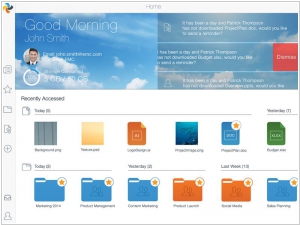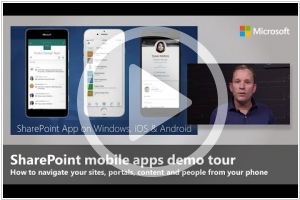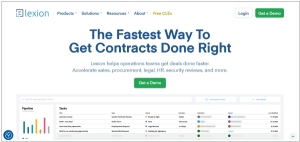SharePoint vs Syncplicity
August 26, 2023 | Author: Michael Stromann
59

SharePoint's multi-purpose platform allows for managing and provisioning of intranet portals, extranets and websites, document management and file management, collaboration spaces, social networking tools, enterprise search, business intelligence tooling, process/information integration, and third-party developed solutions. SharePoint can also be used as a web application development platform.
See also:
Top 10 Cloud Storages for business
Top 10 Cloud Storages for business
SharePoint and Syncplicity are both cloud-based file sharing and collaboration platforms, but they offer distinct features and capabilities.
SharePoint, developed by Microsoft, is a robust document management and collaboration platform that allows users to create, store, share, and collaborate on documents and other content within an organization. It offers a wide range of features such as version control, document co-authoring, workflow automation, and integration with other Microsoft Office applications. SharePoint provides a centralized repository for documents and offers advanced search and metadata capabilities to help users organize and find information efficiently. It also supports team collaboration through features like discussion boards, task management, and shared calendars.
Syncplicity, on the other hand, is a cloud-based file synchronization and sharing platform that focuses on providing secure and seamless access to files across devices and users. It emphasizes ease of use and simplicity, allowing users to sync and access their files from anywhere and share them with colleagues or external parties. Syncplicity provides features like file versioning, real-time collaboration, and secure file sharing with password protection and expiration dates. It also offers advanced security and data protection features such as encryption, remote wipe, and access controls.
See also: Top 10 Cloud Storages
SharePoint, developed by Microsoft, is a robust document management and collaboration platform that allows users to create, store, share, and collaborate on documents and other content within an organization. It offers a wide range of features such as version control, document co-authoring, workflow automation, and integration with other Microsoft Office applications. SharePoint provides a centralized repository for documents and offers advanced search and metadata capabilities to help users organize and find information efficiently. It also supports team collaboration through features like discussion boards, task management, and shared calendars.
Syncplicity, on the other hand, is a cloud-based file synchronization and sharing platform that focuses on providing secure and seamless access to files across devices and users. It emphasizes ease of use and simplicity, allowing users to sync and access their files from anywhere and share them with colleagues or external parties. Syncplicity provides features like file versioning, real-time collaboration, and secure file sharing with password protection and expiration dates. It also offers advanced security and data protection features such as encryption, remote wipe, and access controls.
See also: Top 10 Cloud Storages
SharePoint vs Syncplicity in our news:
2018. SharePoint gets organization-wide news and content targeting
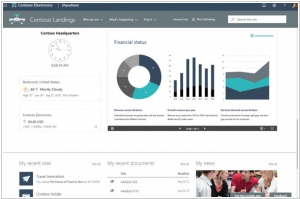
Microsoft has recently announced several enhancements for SharePoint and Office 365 sites, bringing new capabilities and functionalities. Among the notable updates is the introduction of a designated communication site that serves as the official news portal for the organization. This allows news posted on the portal to be easily identified with a special indicator, ensuring clear visibility on both mobile devices and the SharePoint home page. Additionally, a new feature enables the targeting of content to specific audiences based on their Active Directory (AD) Group membership, including dynamic groups. Moreover, SharePoint sites now have the ability to create mega-menus for navigation, facilitating improved user experiences and seamless site exploration. These advancements aim to enhance communication, personalization, and navigation within SharePoint and Office 365 sites.
2017. SharePoint 2016 finally added SharePoint Framework Support
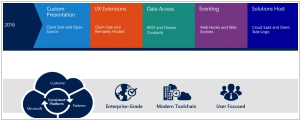
Microsoft's objective in launching SharePoint Framework into general availability in February was to attract a wider pool of developers to the SharePoint ecosystem. Now, with the introduction of SharePoint Feature Pack 2 (FP2), the company extends Framework support to users of SharePoint 2016. Framework serves as a page and web part model, offering comprehensive assistance for client-side SharePoint development, seamless integration with SharePoint data, and compatibility with open source tools. This release simplifies the process for SharePoint 2016 users and third-party developers to construct solutions centered around SharePoint.
2017. SharePoint Framework is generally available

Microsoft has introduced the SharePoint Framework, empowering developers and administrators to construct and deploy components that are utilized by Office 365 users within their production environments. This advancement entails leveraging web technologies to create agile, responsive, and notably mobile-friendly applications on SharePoint. While SharePoint has served as an application and development platform for a considerable duration, the release of the Framework marks a significant stride in enhancing the developer experience. Historically described as unwieldy and challenging, the SharePoint Framework introduces improvements that address these concerns.
2016. Microsoft connects SharePoint Team Sites to Office 365 Groups
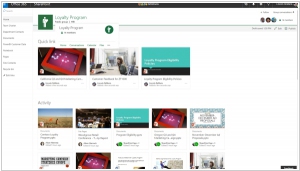
Microsoft is rolling out the integration of SharePoint and Office 365 team sites, introducing a new feature that enables the creation of interconnected SharePoint Online team sites within seconds. This integration simplifies the process as follows: Whenever an Office 365 Group is created, the service automatically generates a SharePoint team site. The appearance of the site can be customized by the team site administrator and includes various elements such as pages, lists, libraries, and team news. SharePoint team sites serve as collaborative spaces where teams can effectively communicate, share documents, and collaborate on projects. They are user-friendly and facilitate the creation of dedicated sites for each project undertaken by the team. Moreover, team sites are easily accessible across multiple devices, making them suitable for mobile workers as well.
2016. Microsoft released SharePoint for Android
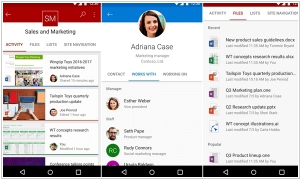
Despite Microsoft's withdrawal from actively competing in the mobile OS market for the past two years, the company has been notably sluggish in releasing Android apps. However, Microsoft has finally unveiled its SharePoint mobile client specifically designed for Android smartphones and tablets. This application offers users the ability to collaborate within team sites and access documents stored in SharePoint across various categories, including Sites, Links, and People. To utilize the SharePoint app, organizations must have an Office 365 subscription that includes SharePoint Online. Support for SharePoint Server 2013 and SharePoint 2016 will be incorporated at a later stage. Earlier this year, Microsoft released SharePoint mobile apps for iOS and Windows Phone, with the latter app still being in the preview stage.
2016. Microsoft brings SharePoint to iOS
Microsoft has introduced a new mobile application for SharePoint users, designed to provide access to a company's SharePoint-powered intranet portal and its content on smartphones and tablets. Initially available on iOS devices such as iPhones and iPads, the app will be extended to Android and Windows platforms by the end of the year, according to Microsoft. The app is compatible with both SharePoint Online in Office 365 and SharePoint Server 2013 or 2016 in on-premises or hybrid environments. It includes a Sites tab that enables users to visit their frequently accessed SharePoint sites, view recent activity, access files, lists, pages, and other content on those sites. Additionally, the app integrates with other Microsoft mobile applications, allowing seamless transitions between apps. For instance, clicking on an Office document in the SharePoint app will open the corresponding Office mobile app, while viewing a document library on a team site will redirect users to the OneDrive mobile app for iOS.
2016. SharePoint adds new document libraries
Now that SharePoint 2016 has arrived, Microsoft is gradually introducing SharePoint Document Libraries to its commercial Office 365 subscribers through SharePoint Online. These new document libraries represent a more user-friendly approach to SharePoint, allowing users to conveniently access documents, modify document metadata, and prioritize content within the document library. This development is significant as it addresses longstanding criticisms of earlier versions of SharePoint regarding usability challenges. Throughout the extensive lead-up to the release of SharePoint 2016, Microsoft pledged its commitment to enhancing the user experience.
2014. EMC Syncplicity cuts prices
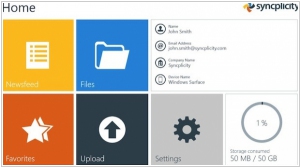
According to industry leaders Forrester and Gartner, EMC's Syncplicity is regarded as the top-notch offering in the Enterprise Sync and Share market. However, EMC aims to eliminate any potential barriers that may prevent companies from fully embracing its comprehensive solution. As part of this effort, EMC has increased storage limits across all its offerings. Individuals with free personal accounts can now enjoy storage capacity of up to 10 GB without incurring any charges. Subscribers to the business edition have a generous allocation of 300 GB + 5 GB per user, with the option to obtain additional storage at a reasonable price. Users of the departmental edition are granted up to 1 TB of storage without incurring extra fees. Furthermore, the storage capacity for the Enterprise edition remains unlimited, as it has always been.
2014. Syncplicity launches iPhone app expanding virtual private cloud capabilities
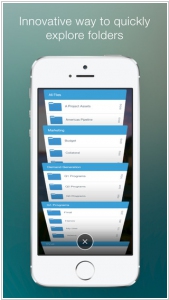
The cloud-based file management service, Syncplicity, has recently launched a new iPhone app that offers mobile accessibility to all user files and folders. This app not only provides convenient access but also fulfills crucial business requirements such as security, backup, and versioning. Users can now effortlessly browse, share, and manage their files and folders directly from their iPhones, regardless of whether the files are stored on their PC, Mac, SharePoint servers, corporate network, or in Google Docs. This universal file access on the iPhone encompasses shared Syncplicity folders designed for collaboration within businesses or for personal sharing. With Syncplicity, users can securely access any file and folder at any time, eliminating the need to rely on email attachments or carry laptops and use VPNs to ensure file access while on the move. Syncplicity also prioritizes mobile safety by incorporating built-in policy and permission controls, remote wipe capabilities, and comprehensive end-to-end encryption for all transferred and stored data on the Syncplicity service as well as on the mobile device.
2013. IBM kills Lotus. Microsoft kills SharePoint
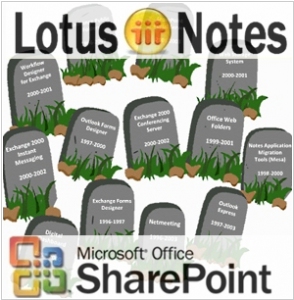
Perhaps the two most famous brands in the history of enterprise software, Lotus and SharePoint, will soon disappear. We mean brands, not specific products. Because by renaming their products, vendors try to erase the association with outdated technologies in customer brain. For example, Lotus appeared back in the 80-s years of last century. In 1995 IBM acquired Lotus Development and began selling their products Lotus Notes/Domino. In the following years most IBM collaboration systems moved under the Lotus umbrella. But last year the revolution occurred. The last child of the Lotus family - SaaS suite LotusLive was renamed to SmartCloud for Social Business. And then the name Lotus was removed from other products. The final nail was the recent launch of Notes/Domino 9.0 Social Edition (without Lotus). ***

